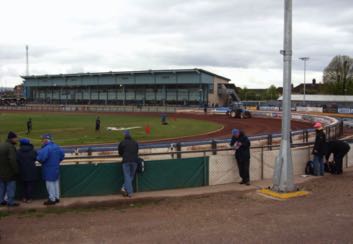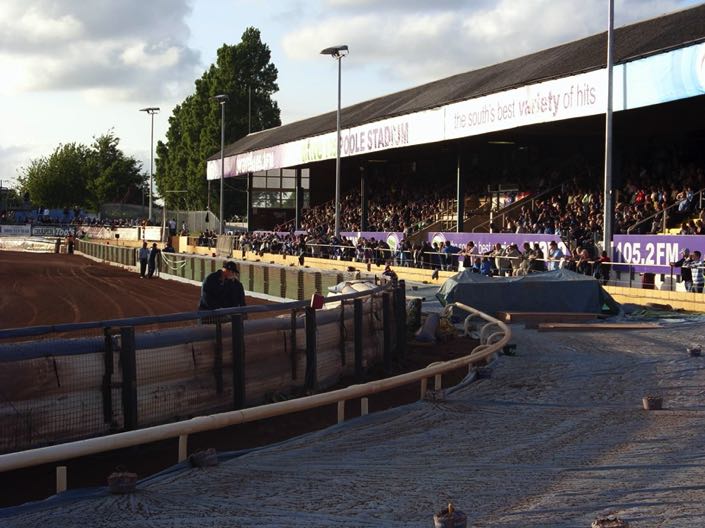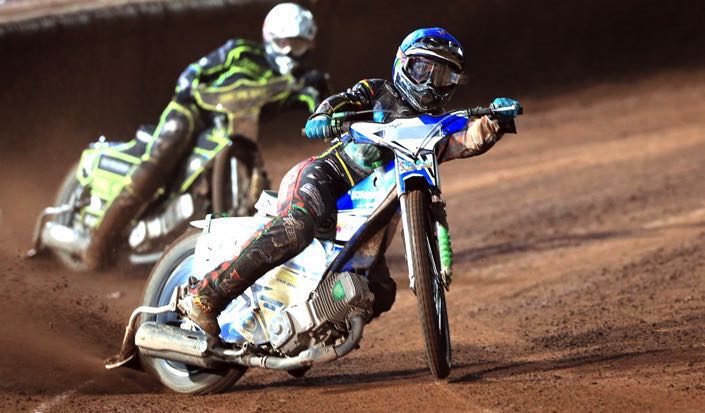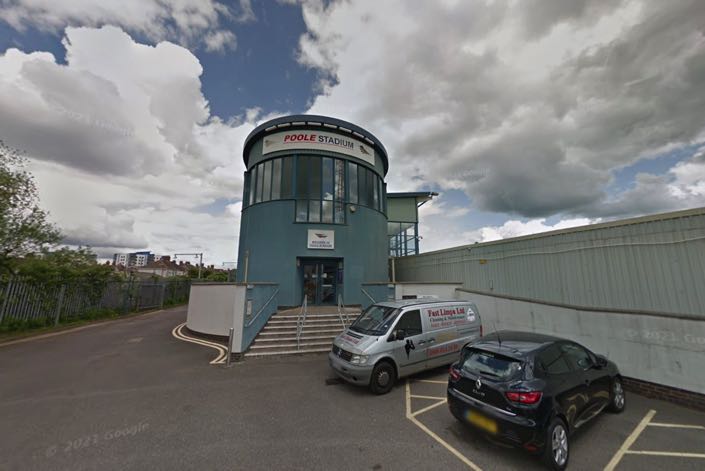- Address: Stadium Way, Poole BH15 2BP
- Status: Permanently Closed

The reality of greyhound racing is that it was always more popular in the north of the country. That isn’t to say that southern venues never existed, however, with Poole Stadium being a perfect example of this. Built in the 1930s, the venue is to be found in the centre of Poole in Dorset and is owned by the Borough of Poole. Those who have read other ‘What Happened To…’ pieces on this site might wonder why we’re referred to Poole in the first person, given that the majority of other stadiums that we’ve talked about no longer exist.
The answer comes in the form of the fact that the stadium itself still exists and regularly hosts speedway events. It is only the greyhound racing that has stopped at the site, which closed permanently on the 22nd of September in 2020. The trainers and their dogs were mostly transferred to Swindon, amongst other racecourses around the country. Having been built as a source of entertainment for the people of Poole during the Great Depression, it is now predominantly a speedway course with a car park that is used for Poole Hospital’s Park & Ride.
Major Races & Events

It is not uncommon for greyhound racing venues to have big races or events attached to them. Indeed, it is usual for these to move from one course to another depending on what was going on at the venue at any given moment. In the case of Poole Racecourse, there was not the demand for major races in the same way as there was at the likes of Belle Vue and Wimbledon Stadiums. This was purely because of the number of people looking to attend race meetings, which wasn’t usually in the same league as the northern courses.
Golden Crest
The biggest race that took place at Poole Stadium was the Golden Crest. Inaugurated in 1937, it was originally run at Eastville Stadium in Bristol. When Eastville closed in 1997, it seemed as though the race was going to finish for good until Poole stepped in and brought it back. That was in 2000, with the race being run over 450 metres. The exception to that was in 2014, when it took place over 640 metres before reverting to its previous length. It enjoyed a couple of sponsors over the years before the race finished when Poole Stadium closed in 2020.
In the News
Normally when stadiums close down, they don’t appear in news stories all that often. Indeed, even when you bear in mind the fact that Poole Stadium plays host to speedway racing, its only mention towards the end of 2022 came in an article about Abbey Stadium in Swindon and even then only because Gaming International owns both venues. For a mention including greyhound racing, you have to go back to 2020, which was when the Poole Pirates declared that they would remain at Poole Stadium even when greyhound racing ended.
About Poole Stadium

Often referred to as Wimborne Road, which runs adjacent to the venue, Poole Stadium was the home of the local football team, Poole Town Football Club, between 1933 and 1994. The semi-professional side played their Western Football League games in the venue, punctuated by a record crowd FA Cup first round replay with Watford in 1962, with 11,155 people turning up to see their side lose. Thankfully, it wasn’t the same 6-0 loss humiliation that they’d faced in 1946, when they played Queens Park Rangers in the same round of the same competition.
When the Poole Pirates speedway team was formed in 1948, it needed a home to play its matches in. Poole Stadium had boasted a cycle track ever since it opened, but this was replaced with the more robust speedway track in order to accommodate the team. It is such an impressive speedway venue that it was chosen to host the Speedway World Cup final in 2004, when more than 7,000 people turned up to watch. The speedway track is officially 299.1 metres long, with the track record of 56.91 seconds having been set in 2006.
Greyhound Racing Arrives
In most of the other venues around the country that host both greyhound and speedway racing, it was the dogs that arrived first before the motorbikes came along later. The opposite is true at Poole Stadium, which didn’t see greyhound racing take place until 1960. That was when Southampton Greyhound Stadium’s owners, Charlie Knott Senior and Charlie Knott Junior, put plans in place to install a track around the football pitch and speedway surface. As a result, stands were introduced on both sides of the venue.
The first meeting took place in front of the Mayor of Poole, Alderman Bill Cole, on the 8th of May, 1961, with him also conducting an opening ceremony. Five dogs per race took part in eight races, which took place around a 380-yard circuit. Count on Chippelgaun won the first race at odds of 5/1, completing the circuit in 29.7 seconds. The appropriately named D. J. Poole was the racing manager, though was replaced by T. H. Pickett not long after the first meeting took place. The Knott’s sold their interest in 1980.
Ups & Downs Over the Years
The greyhound operation worked relatively well for the majority of the time, then it hit trouble in 1985 and closed down temporarily. It was brought back by TGV Limited, which was headed by Terry Bentham. Simon Cross was installed as Racing Manager, with TGV using the opportunity to make improvements to the venue. This included a restaurant for 100 covers, enough room for 800 vehicles in the car park and the installation of an Outside Sumner hare to speed around the newly installed all-sand circuit that the dogs ran on.
Ownership changed to Playbill Limited in 1990, who removed the greyhound track in order to make enough room for a larger football pitch. That remained the case until the football stopped taking place at Wimborne Road, at which point the greyhound racing returned thanks to the BS Group. A modern, glass-fronted grandstand was built in 1997, offering two bars, a restaurant with 312 seats and full Tote betting facilities. The Golden Crest became the most important event at the stadium, taking over from the Wessex Vase.
Track Records at Poole
Despite the closure of the greyhound operation at Poole Stadium, the track records have been recorded for the historical record. Given the fact that the stadium remains in existence, unlike those that were destroyed in order to make way for housing developments, we shouldn’t rule out the possibility of it re-opening at some point in the future. If it does, these records are the ones that the trainers will be trying to get their dogs to break in order to set new ones. Here are how the records across numerous distances stand at the time of writing:
| Distance | Record Time | Date Set |
|---|---|---|
| 230 Metres | 14.38 Seconds | 1989 |
| 232 Metres | 14.41 Seconds | 25th April 1985 |
| 250 Metres | 14.74 Seconds | 22nd April 2017 |
| 445 Metres | 27.43 Seconds | 1989 |
| 450 Metres | 26.20 Seconds* | 13th July 2013 |
| 455 Metres | 27.34 Seconds | 30th August 1983 |
| 630 Metres | 39.92 Seconds | 1989 |
| 632 Metres | 40 Seconds | 25th September 1986 |
| 640 Metres | 38.56 Seconds | 14th April 2007 |
| 840 Metres | 52.06 Seconds | 16th February 2007 |
| 845 Metres | 55.48 Seconds | 1989 |
| 855 Metres | 54.86 Seconds | 12th July 1986 |
| 445 Metre Hurdles | 28.90 Seconds | 1989 |
*Record was set during the final of the Golden Crest
The Closing of the Track: What Happened to Poole Stadium?

In 2018, a deal was signed with Arena Racing Company to allow for racing on Tuesday and Sunday evenings. This lasted a little under two years, at which point the global health crisis resulted in the closing down of the stadium for an unknown length of time. When lockdown restrictions eased, Poole Stadium Limited, which was now owned by parent company Gaming International, didn’t re-open. On the 5th of August, it was announced that there was a consultation period taking place with the staff and that the greyhound racing might not return.
On the 22nd of September in 2020, Gaming International confirmed that the greyhound racing operation would not be returning to Poole Stadium. As a result, Gaming International had just one remaining site under its greyhound portfolio, which was Swindon Stadium. Despite the ending of the greyhound races, Poole Stadium continued operating as a location for speedway events, which remains the case to this day. The greyhounds and their trainers were mostly moved to alternative locations around the United Kingdom.